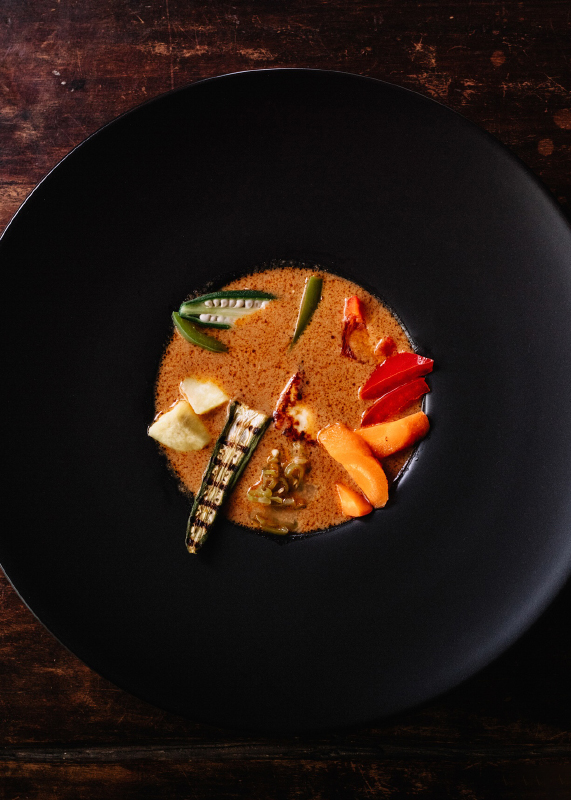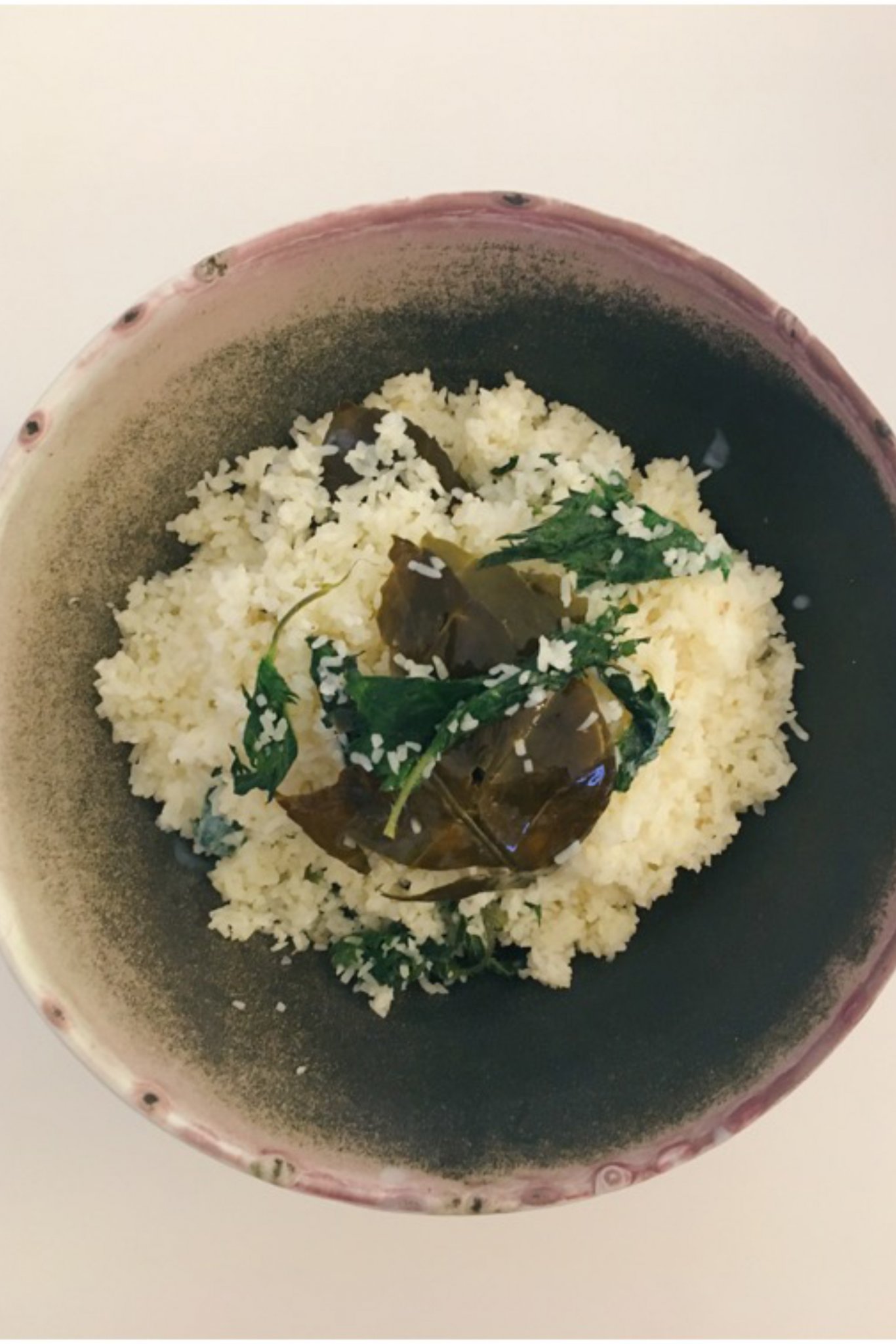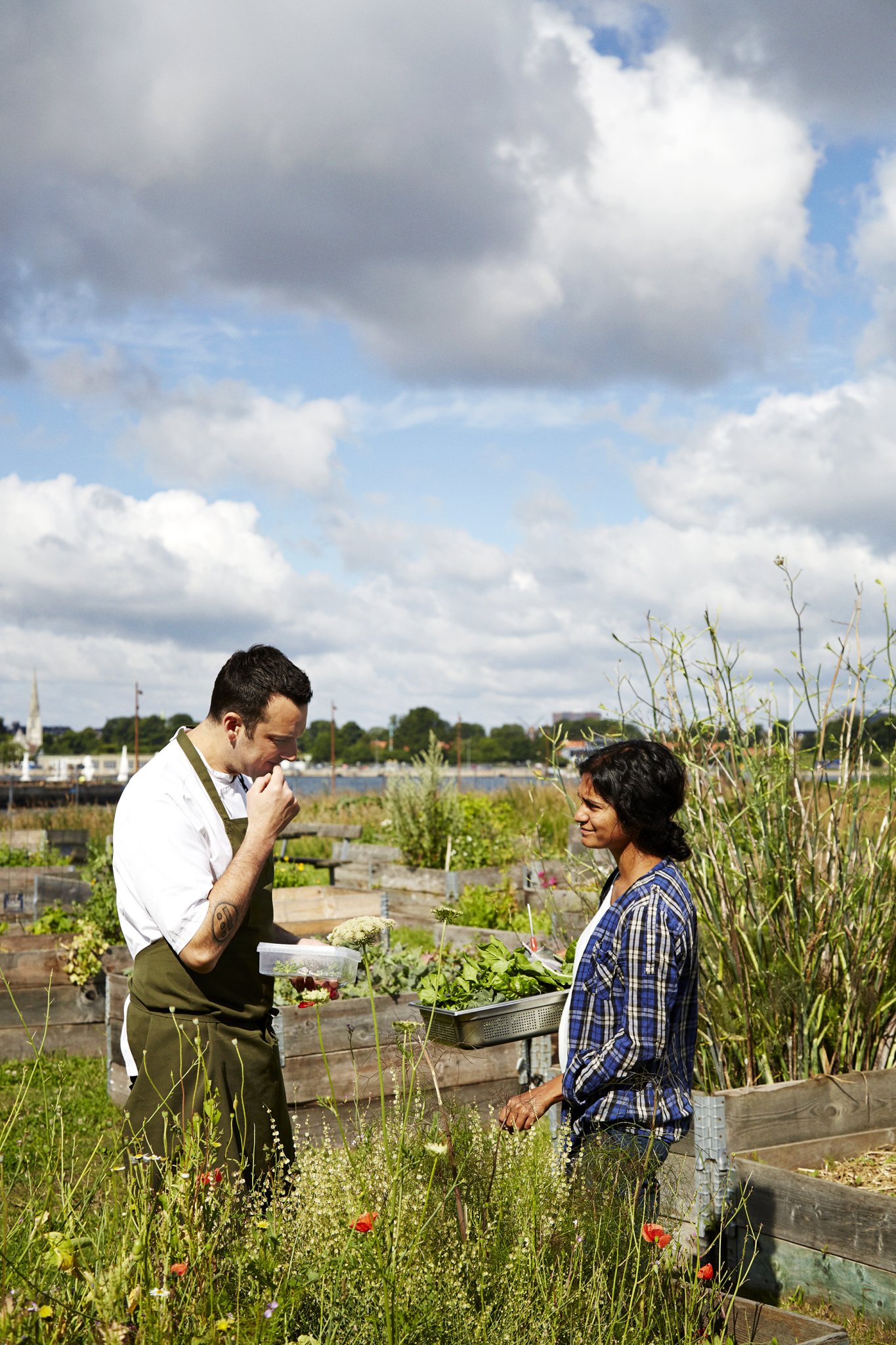The United Nations’ ActNow Climate Campaign aims to trigger individual action on the defining issue of our time. People around the world will be engaged to make a difference in all facets of their lives, from the food they eat to the clothes they wear. One of these challenges focuses on sustainable food and gastronomy.
Being climate conscious
What we eat has major implications for climate change. The destruction of rainforests to create land for agriculture, along with growing demand for meat, are major contributors to the increasing greenhouse gases which are taking a significant toll on climate and global food security. To top it off, we waste about one-third of the food that is produced. But more people are taking a closer look at what they are eating and the impacts of their diets on their health and on the environment. More and more chefs and other food suppliers are focusing on local and organic produce and shifting away from meat-heavy meals and fast food. They are joined by a growing movement of people changing the way they cook and eat. The UN’s ActNow campaign aims to inspire even more people to enjoy sustainable, climate-conscious and delicious food.
Chef Grace Ramirez talks about sustainability and green hacks in support of the United Nations ActNow climate campaign
Food Challenge
ActNow invites people around the world to make their individual contribution to sustainable food consumption. The challenge: cooking up dishes that are not only delicious but also good for the planet and good for us – reducing meat and emphasizing diverse vegetarian ingredients instead. Leading chefs will spearhead the challenge and provide inspiration by presenting their own creations which you can find on this page. Get cooking!
Chef Saliha Bala
Red Chorba
This soup is a delicious vegetarian traditional Algerian dish.
Ingredients
- 1 liter of veggie stock
- 1 branch of celery
- 1 small onion
- 1 carrott
- 1 zucchini
- 1 turnip
- 1 small potato
- 1 cup of frozen peas(or fresh, if seasonal)
- ½ cup of green lentils
- 1 cup of soup pasta (angel hair pasta or farfalle)
- 1 tomato tin, or 4 juicy tomatoes (if seasonal)
- 1 tsp of tomato puree olive oil
- ½ flat parsley bunch
- ½ fresh coriander bunch
- Spices to taste: ras-el-hanoutjaune, smoked paprika, black pepper, cinnamon, powdered ginger, salt
Method
- Chop all the vegetables into medium cubes. Set the zucchini aside.
- Using a large pot, cook the onion on medium heat with the all the spices, the carrot, lentils and the potato in 4 tsps of olive oil until soft, this is bring out all the flavours.
- Add the tomatoes (fresh or tinned and pureed), then fill half the pot with the veggie stock, scraping the bottom of the pot.
- Let it simmer, then add the zucchini. Let cook until soft.
- Season to taste. Add more water, if necessary.
- You could add angel hair pasta or any kind of little pasta 10 minutes before serving, I suggest to adjust the soup you need and cook the pasta in it, and set
- Set aside any leftovers for next time.
- Serve hot with a generous handful of chopped flat parsley and coriander.
- Turn your best «chaâbi» music on and enjoy yourselves.
Saha ftourkoum! Bon appétit!
Full recipe here
#ActNow #ClimateAction | Courtesy of Kitchen Connection
Everyday vegetables roasts with condiments | Chef Jonas Astrup
Serves 4-6
Ingredients
Vegetables
- 1 broccoli
- 1 cauliflower
- 1 celearic
- 1 hokkaido pumpkin
Brown butter vinaigrette with miso
- 100 g butter
- 1 tbsp. miso
- 2 tbsp. spring onion
- 1 handful parsley
- 2 tbsp. capers
- 2-3 tbsp. applecider vinegar
- Salt
Sunflower seed spread
- 70 g sunflower seeds
- 1 clove of garlic
- 2 dl vegetable oil
- Apple cider vinegar
- Salt
- Pepper
- Honey
Pumpkin seed spread
- 80 g pumpkin seeds
- 1 clove of garlic
- 2 dl vegetable oil
- 1 lemon
- Salt
- Pepper
- Honey
Mushroom “ketchup”
- 200 g mushrooms
- 1 dl vegetable oil
- 3 cloves of garlic
- 1 ½ dl sugar
- 1 dl vinegar
- Salt
- Pepper
Black garlic dip
- 6 cloves of black garlic
- 1 dl yoghurt 10%
- ½ lemon
- Salt
- Pepper
- Honey
Dill dressing
- 1 dl yoghurt 10%
- 1 handuld of dill
- ½ lemon
- Salt
- Pepper
- Honey
Directions
Roasting vegetables
Turn on the oven at 175°. Clean and prepare vegetables; peel the celeriac and perhaps cut the pumpkins in half). Turn each vegetable in a bit of vegetable oil and season with salt and pepper (and if you prefer, some of your favorite spices).
Cooking time (approximately):
- Broccoli: 20-25 minutes
- Hokkaido pumpkin and butternut squash: 30-35 minutes
- Cauliflower: 30-40 minutes
- Celeriac: 60-90 minutes
Brown butter vinaigrette with miso
Brown the butter in a small saucepan while whisking in order to not burn the whey. Take it off the heat and stir in the miso. Finely chop the spring onions, parsley and capers and add it to the butter mix. Season with apple cider vinegar and salt.
Sunflower seed spread
Turn on the oven at 150° and roast the seeds for 13-15 minutes. Grate the garlic on a grater and blend it with the sunflower seeds and the oil until you’ve achieved a smooth consistency. Season with salt, applecider vinegar, pepper and honey.
Pumpkin seed spread
Turn on the oven at 150° and roast half of the pumpkin seed for 13-16 minutes. Grate garlic and lemon zest on a grater and blend it with the roasted and raw seeds and oil until you’ve achieved a smooth consistency. Season with salt, lemon juice, pepper and honey.
Mushroom “ketchup”
Clean and cut the mushrooms and fry them in a frying pan with oil until lightly browned and caramelized. Peel and chops the onion and garlic and toss them in the pan with mushrooms. Let is saute for another 5-8 minutes. Add sugar and vinegar and cook it through thoroughly. Add everything to a blender and mix it to a smooth ketchup-like consistency. Make sure the balance is right – season with salt and pepper.
Black garlic dip
Blend the black garlic with yogurt until you have a smooth dip. Season with lemon juice, salt, pepper and a bit of honey.
Dill dressing
Clean and finely chop the dill. Mix it together with the yoghurt and season with lemon zest and juice, salt, pepper and perhaps a bit of honey.
#ActNow #ClimateAction | Courtesy of MAD, a global community of chefs that aims to create sustainable change and make a difference in restaurants and the world
Waste-free Omelette with Vegetables | Dr. Yukio Hattori, Japanese Food Educator
Using your leftover ingredients to make a delicius omelette is an excellent way to create a waste-free meal! For all ingredients you can use any remaining vegetables in your fridge. Here is an example of what Dr. Yukio Hattori used! You can easily substitute the vegetables.
Ingredients
For 4 servings
- 5 eggs
- 1/8 of an onion*
- 1/4 of a bell pepper*
- 1/2 pk. of pea sprouts*
- 2 mushrooms*
- 1 cabbage leaf*
- 2 tops of long green onions*
- Olive oil as necessary
- 1/3 pk. of leftover potato chips
- 2 tsp salt
- Pepper to taste
Aioli sauce
- 1 garlic clove
- Mayonnaise as necessary
- Milk as necessary (if available)
Instructions
- Cut all ingredients marked with an asterisk into bite-sized pieces.
- Heat a sufficient amount of olive oil on a fry pan and stir the ingredients from Step 1. Continue to cook with medium heat until all ingredients are fairly soft.
- Crack the eggs into a bowl and mix thoroughly.
- Put the mixture from Step 2, along with hand-crunched potato chips, in the bowl and combine all ingredients.
- Heat additional olive oil in a small fry pan and pour in the mixture from Step 4.
- Cook both sides of the omlelette using medium, making sure not to scorch the omelette.
Instructions for making a simple aioli sauce
Add grated garlic to the mayonnaise and mix in milk until the desired consistency is reached.
Cut omelette into convenient-sized slices and garnish with aioli sauce and enjoy!
#ActNow #ClimateAction | With thanks to UN Information Centre Tokyo
Chef Denise Browing
Brazilian Vegetarian Feijoada / Feijoada Vegetariana
Feijoada – black beans and pork stew – is considered Brazil’s national dish. This is the vegetarian version of the iconic dish which is usually slowly cooked on stove top for hours. This recipe is an energy-saver as it is cooked in a pressure-cooker, shortening the cooking time significantly.
Deep Fried Bananas / Empanada Banana
A Brazilian versatile dish that can be served as a side dish for beans or feijoada or as a dessert topped with caramel and/or ice cream. It only takes about 2 minutes to cook on the stove top which helps conserve natural resources.
Full recipes here:
#ActNow #ClimateAction | Courtesy of Kitchen Connection
Optimal Fruit Salad / Ensalada de Frutas Óptima | Chef Palmiro Ocampo
People ask us what else can I do with the banana peel? The #recetaoptima shows another use for it. It is a fruit salad accompanied by honeyed and delicious strips of banana peel completely covered in cinnamon powder and accompanied with candied banana peel.
Process – 30 min
- Season fruits. You can take the ones you like.
- Cut them to your liking. In this case we have done it in small squares.
- At the same time, remove the brown and white part of the banana peel. We cut into strips and keep them in water for a while.
- Add 3/4 cup of water to a pot, add 4 spoons of sugar (medium heat). Once the boil breaks, place the strips. Lower the fire.
- Keep simmering approx. 15 to 20 min. We remove softly and leave to cool.
- We remove the strips, wait for them to cool down a bit. Combine them with cinnamon and preserve them.
- We present and decorate with the strips full of cinnamon.
ESPAÑOL
Se trata de una ensalada de frutas acompañada de melosas y ricas tiras de cáscara de plátano completamente cubiertas de canela en polvo.
Proceso 30 min.
- Frutas de estación. Puedes tomar las que gustes.
- Pícalas a tu gusto. En este caso lo hemos hecho en cuadritos.
- A la par, retiramos la parte marroncita y blanca de la cáscara de plátano. Cortamos en tiras y las conservamos en agua un rato.
- Ok, ahora, 3/4 de taza de agua a una olla, agregamos 4 cucharas de azúcar (fuego medio). Una vez rompa hervor colocamos las tiras. Bajamos el fuego.
- Mantenemos a fuego lento aprox. 15 a 20 min. Removemos de forma suave y dejamos.
- Retiramos las tiras, esperamos que enfríen un poco, combinamos con la canela y las conservamos.
- Presentamos y decoramos con las tiras llenas de canela.
#ActNow #ClimateAction | Courtesy of UNIC Peru
Groundnut Soup | Chef Selassie Atadika
One of my favourite lessons from the African kitchen is the use of nuts and seeds to provide plant-based protein, a rich creamy finish and of course, deliciousness. This dish is a great way to make use of leftover vegetables. In addition to being a great soup, it also makes a great sauce drizzled over steamed or grilled vegetables.
INGREDIENTS
Servings: 6 servings of 8 oz/one cup each
- 1 1/4 cups smooth natural peanut butter or groundnut paste (unsweetened)
- 1/4 cup tomato paste
- 1 tsp cayenne pepper, powder
- 8 cups vegetable stock
- 1 tsp fresh ginger, grated
- 1 Tbsp mushroom powder
- 1/4 cup onion, finely minced
- 2 tsp salt
- Chili to taste
- Add blanched or sautéed vegetables of choice; examples include: green beans, eggplant, carrots, okra and/or cauliflower
DIRECTIONS
Mix peanut butter and tomato paste with cayenne pepper selection of vegetables in a pot, slowly blend in 2 cups stock. Cook on medium heat, cover and stir occasionally for 20 minutes. Add remaining 6 cups stock, stirring in slowly. Reduce heat to medium-low. Add ginger, mushroom powder, onion, chili and salt. Boil for 30-40 minutes, stirring occasionally until the oil separates and comes our of the groundnut paste*. Add in the sautéed or blanched vegetables to the soup and let it cook for a few minutes before serving. Serve alone, or with starch of choice.
*Please note that if you don’t wait let the soup cook until the oil separates, it can cause discomfort during digestion.
#ActNow #ClimateAction | Courtesy of MAD, a global community of chefs that aims to create sustainable change and make a difference in restaurants and the world
Okra Stew | Zoe Adjonyoh
Okra is an ingredient commonly used in west Africa, as well as in my restaurant kitchen and home. As a child a slimy okra stew was like a bowl of snotty porridge. When I started Zoe’s Ghana Kitchen I looked for new ways to incorporate okra into dishes, one being Okra tempura. This dish demands super fresh crisp okra—sometimes someone over orders and we have a surplus.
Okra stays fresh uncut for about 7-10 days when refrigerated, but doesn’t last forever. When you see okra reduced to one pound a bowl at the grocer’s, looking a little peaky, and slightly bruised plum or beef tomatoes in the discount bin, there is still life in them yet. So grab that bargain and cook this leftover Okra Stew. It’s one of my absolute favourites and of the most traditional Ghanaian dishes I cook.
Zoe Adjonyoh’s leftover Okra Stew
A famous West African dish, it traditionally calls for finely chopped and separately boiled okra, to create a very slimy sauce. I’m not a fan of slimy okra, so instead I slice mine slightly less than 1cm (1/2 inch) thick—the smaller you cut okra, the more mucilage in the pods it releases, a process only further developed by boiling. So by adding the sliced okra straight to the stew, you can avoid slimy okra soup.
INGREDIENTS:
- 200ml (7fl oz) sustainable red palm oil or carotene oil (can be substituted for coconut, rapeseed or sunflower also)
- 1 tsp chilli powder
- 1 tsp extra hot curry powder
- 1 tsp cooking salt
- 2 medium red onions, finely diced
- 2 garlic cloves, very finely chopped or grated
- 7.5cm (3-inch) piece fresh root ginger, finely grated (un-peeled if organic)
- 1 Scotch bonnet or habanero chilli, deseeded and diced
- 750g ripe plum tomatoes, cubed or blended
- 1 tablespoon tomato purée
- 250ml (9fl oz) good-quality vegetable stock
- 500g (1lb 2 oz) okra, trimmed and sliced
- 150ml (5fl oz) water
Chopped Coriander and sliced Anaheim chillies to garnish

Photo by Nassima Rothaker
1 | Heat the oil on low–medium heat until it melts (palm oil has a low smoke point, so be careful not to let it burn), add the onion and sauté gently for a few minutes until translucent. Add the spices, garlic, ginger and Scotch bonnet and stir well, then sauté for a further 5 minutes.
2 | Cook in the tomato purée stirring well, then pour in the vegetable stock to de glaze the pan, reduce the heat to low, and then add the tomatoes and salt. Cover and simmer for 25 minutes until they start to lose their tartness.
3 | Add the sliced okra to the pot with the measurement water, stir though once or twice and replace the lid and simmer for a further 15-20 minutes until the okra is just tender. Season to taste.
This dish is traditionally served in a bowl with banku on a side plate along with a finger bowl.
#ActNow #ClimateAction | Courtesy of MAD, a global community of chefs that aims to create sustainable change and make a difference in restaurants and the world
Perfect Loose-Leaf Green Tea | Henrietta Lovell, Rare Tea Lady
Tea bags use forests, industrial chemicals, plastics, glues, and bleaches, and create unsustainable waste. Even a completely biodegradable bag is made using chemicals and precious resources. A teapot can be passed down through generations and flood your life with pleasure.
Making great tea needs a recipe just like a cake. You can’t just add some flour and butter, a few eggs, cook for some time, at some temperature and hope to get a perfect sponge. With tea the recipe is simple – you need to control three things:
- How much leaf to water
- Temperature
- Infusion time
Ingredients
Makes a pot to share for 2
- 5g of whole leaf green tea (Direct Trade if you can find it – giving the best deal possible to the farmer who grew and crafted it).
- 250 ml of boiling water
- 50 ml of cold water
Method
- Pop the tea in the teapot
- Add 50ml of cold water over the leaf
- Add 250ml of boiling water on top. This combination brings the temperature to just above 70 degrees. The best flavours in green tea dissolve at this lower temperature and you’ll get a sweeter more delicious cup. Boiling water releases the tannins that can dominate and make the tea bitter.
- Infuse for 90 seconds.
- Strain to the last golden drop into 2 teacups (don’t leave any water in the bottom of the pot to over extract).
Sip to your hearts delight!
When you are ready you can repeat with the same leaves making a second and possibly third delicious infusion. The second if often better than the first.
#ActNow #ClimateAction | Courtesy of MAD, a global community of chefs that aims to create sustainable change and make a difference in restaurants and the world
Pasta with Mint and Breadcrumb Pesto | Massimo Bottura
Ingredients
Mint and breadcrumb pesto
Serves 6
- 7 oz (200g) basil leaves
- 2 oz (50 g) parsley leaves
- 4 oz (120 g) mint leaves
- 1 oz (25 g) stale bread, finely crumbled (scant 1⁄2 cup)
- 2 garlic cloves, chopped
- 2 tablespoons plus 2 teaspoons extra-virgin olive oil
- generous 1⁄2 cup (50 g) freshly grated Parmigiano Reggiano cheese
- 1 tablespoon sea salt
Pasta
- 1 tablespoon coarse salt
- 1 lb (600 g) fusilli pasta or other short pasta
- Freshly grated Parmigiano-Reggiano cheese, for serving
Method
Mint and breadcrumb pesto
In a blender or food processor, combine the basil, parsley, mint, breadcrumbs, garlic, and 5 ice cubes and pulse until finely chopped. Add the olive oil, Parmigiano, and salt and pulse to incorporate.
Prepare the pasta
Bring a large pot of lightly salted water to a boil over medium heat. Add the fusilli and cook until al dente. Toss the pasta with the pesto. Sprinkle with the grated Parmigiano and serve.
#ActNow #ClimateAction | Courtesy of MAD, a global community of chefs that aims to create sustainable change and make a difference in restaurants and the world
Broken Rice with Nettles and Lemon Leaves | Skye Gyngell
This dish is typically served alongside venison with buttermilk and spices and pullet eggs and celery salt, but can just as easily be enjoyed without meat!
Ingredients
Serves 4
- 300g broken rice (most middle eastern food stores stock this)
- 170ml coconut milk
- 170ml water or vegetable stock
- Salt
- 100g nettles, leaves only (make sure you wear gloves when picking)
- 5 lemon leaves, washed
- Sugar
- Pepper
- Coriander for garnish
Method
- Wash the rice well under cold running water to remove any excess starch and transfer to a saucepan which has a tight-fitting lid.
- Mix the coconut milk and stock together and pour it over the washed rice. Stir in the nettles and lemon leaves.
- Cover the saucepan with a lid and bring the rice to boil on high heat.
- Once vigorously boiling, change to a low heat, cover with the lid and allow to simmer for 10 minutes, or until the water level is the same as the top of the rice.
- At this point, turn the heat completely off and allow to rest for a further 10 minutes, keeping the lid on at all times. Use a wooden spoon to fluff up the rice before serving. Add salt, sugar and pepper to taste.
- Garnish with coriander
#ActNow #ClimateAction | Courtesy of MAD, a global community of chefs that aims to create sustainable change and make a difference in restaurants and the world
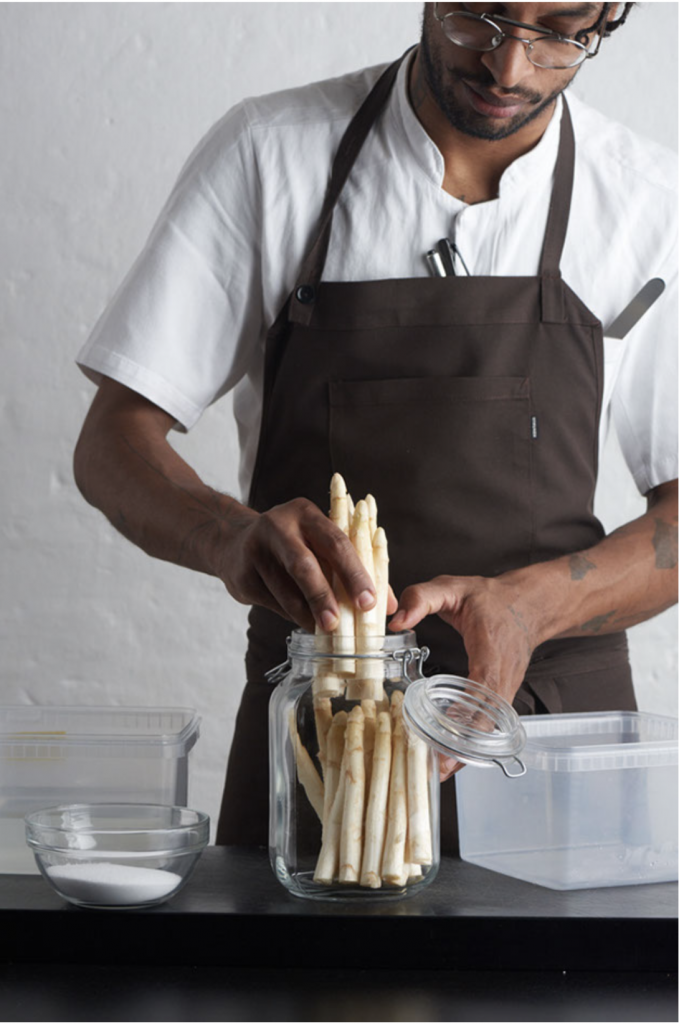
Lacto-Fermented Asparagus | David Zilber
Vegetables often come packaged in bundles to guarantee stores sell through their stock. Being locked into buying more than you need can leave you feeling guilty for throwing something away if you didn’t get to it in time. What do you do with excess ingredients before they spoil? Take them out of the fridge and let them rot in your favour.
Fermentation, a practice invented countless times over around the world and throughout history, was one of humanity’s first means of food preservation. By harnessing these ancient techniques you can divert waste and keep food edible longer. Thereby buying less, thereby producing less in the first place. Even in the face of a seemingly insurmountable challenge, practicing simple acts like fermentation at home, can be the spark of hope that keeps us fighting for a better future.
Ingredients
- (sea) salt
- water
- lemon (sliced)
- 1/2 bunch asparagus (or whatever amount you have left!)
Instructions
- Using a large, re-purposed glass jar capable of holding the asparagus upright, wash out your jar with very hot water—a hot dishwasher cycle works too. Once it’s clean and dry, place your jar on a scale, and tare the scale to zero it.
- Place your asparagus in, and fill the jar with cool water up to its neck.
- Multiply the weight of the water and asparagus by 0.04. That number is the amount of salt you’ll need (sea salt works best if you have it). To form your brine, weigh out the salt, place it into a large bowl, and pour in the water from the jar. Stir the water well to dissolve the salt. Now, pour that salty brine back over your asparagus.
- Lay 3-4 pinky-finger-thick slices of lemon underneath the jar’s neck to keep the stalks submerged (this is very important!). Close the lid (loosely!) and set it out at room temperature. Wild lactic acid bacteria already on the veggies and your hands will begin to sour the asparagus, pickling it in an acidic brine. The asparagus will soften, and the brine will become slightly cloudy as time passes.
Let the microbes take their course for 10-14 days.
Five minutes of work transforms wilting asparagus into a sour, crunchy snack! Slice your pickles into coins to toss through a salad, or enjoy them in place of kosher dills on a Portobello mushroom burger. Move the jar to the fridge to keep your pickles for months. This recipe works with many firm fruits like cherries or plums; roots like carrots, daikon or beets, cabbages, radishes; and whole swathes of the edible world.
#ActNow #ClimateAction | Courtesy of MAD, a global community of chefs that aims to create sustainable change and make a difference in restaurants and the world
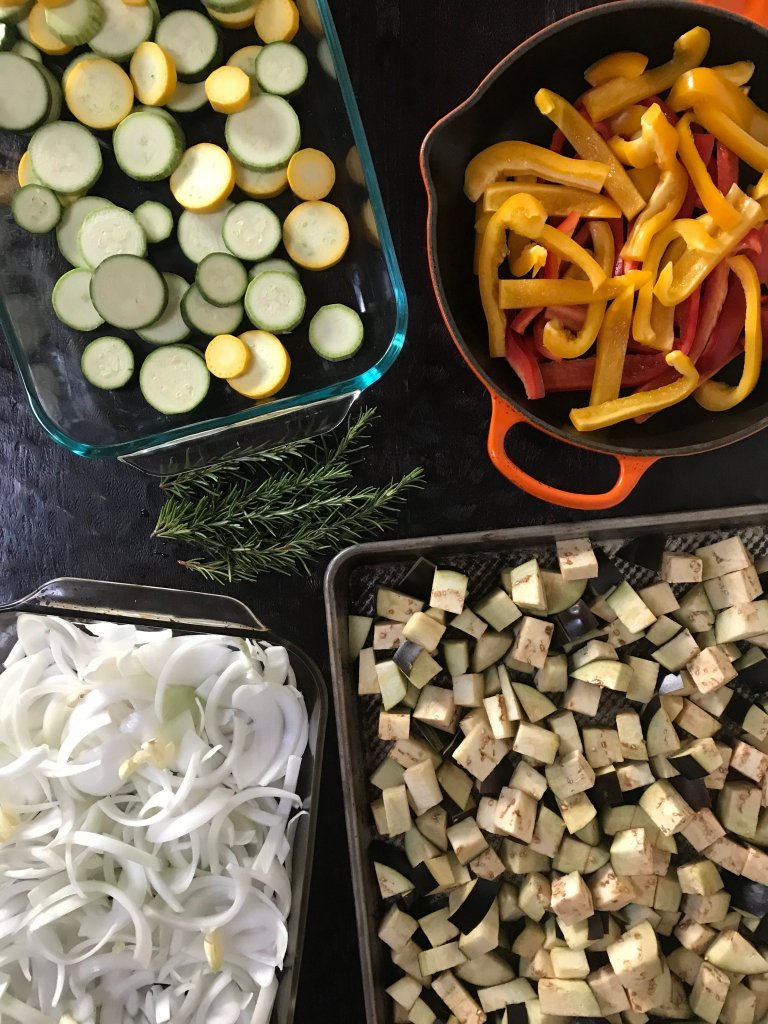
Reduce Food Waste | Anne-Marie Bonneau
While 800 million people on the planet go hungry, we waste a third of the food we produce. Wasted food squanders not only the food itself, but also the water, energy, land, inputs and labor needed to produce it. When compacted in a landfill, wasted food generates methane gas, a greenhouse gas much more potent than carbon dioxide. In the developing world, much of this food waste occurs in homes at the consumer level. The good news about food waste? We can eat the food!
If you went shopping before you started following the #ActNow campaign, food waste might not have been on your radar. With the best intentions to eat healthy all week, you bought all kinds of fresh vegetables. You even transformed old clothes into reusable shopping bags to bring along. Bravo! But then life interrupted your plans and you haven’t made much of a dent in your produce. How can you use up these vegetables quickly, easily and deliciously? One method is to simply roast them.
- Use separate sheet pans or cast iron pans for different types of vegetables, as some require more time in the oven than others.
- Cut the vegetables into bite-size pieces and spread them in a single layer on your pans.
- Drizzle each pan with a couple of tablespoons of olive oil and, if you have it, top them with smashed garlic.
- Sprinkle lightly with salt.
- Add fresh sprigs of herbs if desired.
- Roast at 350F until tender and stir every 15 minutes or so.
- Depending on what kinds of vegetables you roast, some will be ready in 20 minutes and some not for an hour – check regularly.
Eat your roasted vegetables straight out of the oven, purée them with some vegetable broth to make soup, purée a few to add to hummus, toss them in a grain bowl or a salad or even sneak a few cubes into your kids’ smoothies. You’ve not only prepared delicious food, you’ve prevented a pile of food waste. Bon appétit!
#ActNow #ClimateAction | Courtesy of MAD, a global community of chefs that aims to create sustainable change and make a difference in restaurants and the world
Jackfruit Spread | Garima Arora
Chef Garima Arora shares with us her 100% vegetarian main course. It is a spread of cooked unripe jackfruit served with bread (made from ripe jackfruit) and homemade pickles. This dish is a true testament to how Indian cooking techniques can draw the most flavors out of vegetables and transform them into something absolutely delicious. It will leave you feeling so satisfied that you won’t even miss meat.
Ingredients
- 1 unripe jackfruit
- 2 tbs ghee
- 1/2 tsp cumin seeds
- 2 chopped red onions
- 3 pc coriander roots
- 1/2 tsp red chili powder
- 1 tsp dry mango powder
- 5g dry mango pieces
- Salt to taste
- 5 L (approx.) water
Method
- Warm ghee in a pan, add cumin and onions. Cook until the onions are pink.
- Add all the other ingredients.
- Bring the liquid to a boil.
- Add the peeled and sliced jackfruit and cook for 18 -20 minutes, covered.
- Rest for 40 min in the pot.
This recipe can be paired with bread of your choice.
#ActNow #ClimateAction | Courtesy of MAD, a global community of chefs that aims to create sustainable change and make a difference in restaurants and the world
Pumpkin Cheese Cake | Prateek Sadhu
Note: All parts of the pumpkin are used in this recipe. The three parts being: the pumpkin pulp, pumpkin skin and pumpkin seeds/guts.

Pumpkin Cheesecake | Serves 6
Directions
For Cheesecake
- Pumpkin puree – 250 g
- Cream cheese – 100 g
- Pecorino cheese – 28 g
- Egg yolk – 2 ea
- Corn starch – 25 g
- Garlic – 2 cloves
- Butter – 20 g
- Vegetable stock – 40 to 50 ml
- Skin of one whole pumpkin
- Sunflower microgreens (Substitute with microgreens of your choice!)
- Ghee / Clarified butter – for frying & marinating
- Salt & pepper – to taste
For Pumpkin Seed Granola
- Pumpkin seeds – 50 g
- Pumpkin guts (remains from 1 pumpkin)
- All-purpose flour – 30 g
- Butter – 20 g
- Sugar – 10 g
- Salt – 2 g
Cheesecake preparation
- For pumpkin purée, cut pumpkin into wedges. Marinate pumpkin with salt, pepper, ghee and garlic. Wrap it in foil and bake at 180 degree Celsius for 30-40 minutes, until completely cooked.
- Using a spoon, scrape pumpkin pulp off its skin. Keep pumpkin skin aside.
- Blend pulp with butter and vegetable stock till smooth, to make a thick purée.
- Pan fry pumpkin skin with ghee until light, golden brown.
- Line baking tray with aluminum foil, and place pumpkin skin. Keep aside.
- Fold in pumpkin puree, cream cheese, pecorino cheese and salt – mix until there are no lumps. Mix corn starch and yolks, and fold into the above. Layer over pumpkin skin. Bake at 160 degrees Celsius for 30 minutes. (Test texture with a toothpick or knife.)
- Once cooled, cut into any shape as required.
Granola preparation
- Dehydrate pumpkin guts or remains of 1 pumpkin. (Alternatively, roast at 60 degrees Celsius until completely dry.)
- Toast pumpkin seeds on a skillet and roughly grind with dehydrated pumpkin guts. Keep aside.
- Cream butter and add flour, mix to get a crumbly texture.
- Add seeds, guts, sugar and salt and mix with above.
- Bake on a tray at 160 degree Celsius for 5 minutes.
Assembly
- Cut cheesecake into desired shape.
- Spread wholegrain mustard over it.
- Layer with pumpkin seed granola.
- Add sunflower (or local) microgreens.
#ActNow #ClimateAction | Courtesy of MAD, a global community of chefs that aims to create sustainable change and make a difference in restaurants and the world
Saving Water | Matt Orlando
Saving and repurposing water is essential to live – and cook – sustainably. Chef Matt Orlando shares this green hack that he and his team use every day at his restaurant in Copenhagen, Denmark.
“Living your life or running your restaurant in a more environmentally responsible way can seem like a daunting task, and in many ways it is. So, our suggestion is to start somewhere manageable, a place where you’ll see and feel almost immediate results, something that quickly becomes a habit more than task: Save your water.”
“We save a minimum of 90 liters of water a day – water that would otherwise have gone down the drain – by collecting partially full water bottles from the dining room and clean water and ice used in various processes in the kitchen, then using it to wash the floors and water our garden. It saves water, saves energy, saves money and it’s incredibly simple.”
#ActNow #ClimateAction | Courtesy of MAD, a global community of chefs that aims to create sustainable change and make a difference in restaurants and the world

















